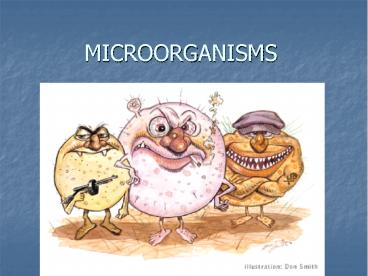MICROORGANISMS - PowerPoint PPT Presentation
Title:
MICROORGANISMS
Description:
Bacteria ... microorganisms – PowerPoint PPT presentation
Number of Views:2231
Avg rating:3.0/5.0
Title: MICROORGANISMS
1
MICROORGANISMS
2
Objectives
- Identify 5 classes of microorganisms
- Differentiate between pathogens and non pathogens
- Identify some common diseases cause by pathogens
3
- Diseases are caused by a variety of
- germs (pathogens).
- Healthcare workers MUST understand
- the different types of
- pathogens (germs),
- Ways pathogens are spread
4
- This allows the HCW (Healthcare Worker) to take
precautions to prevent the spread of disease
5
Microorganisms(2 types)
- Non-Pathogen (a microorganism that does not cause
a disease) - Pathogen (a microorganism that causes infection
or diseases) - Some microorganisms live in 1 system but cause
infection if get into another
6
PATHOGENS
- Microorganism-small, living organism that are not
visible to the naked eye that can cause an
infection - Must be viewed under a microscope
- Found everywhere in the environment
- On and off the human body
7
5 classes of Microorganisms
- Bacteria
- Protozoa
- Fungi
- Rickettsiae
- Viruses
8
1 Bacteria
- Antibiotics are used to kill bacteria
- Some strains of bacteria are resistant to
antibiotics - Must continually develop newer antibiotics to
treat bacteria - Staphylococci, streptococci, meningitis,Pneumonia,
toxic shock, boils, wound infections
9
CocciRound
10
Cocci/Pairs
- Called diplococci
- Cause disease such as gonorrhea, pneumonia,
Meningitis
11
Cocci Bacteria/Clusters
- Staphylococci
- MRSA
- Cause pus
- Infections
12
Strep Throat/Chains of Cocci
13
Rods
14
TB, Pertussis, Botulism
15
Spirillus (spiral-shaped) bacteria
- Cause syphilis and cholera
16
Syphilis
17
2 Protozoa
- 1-celled animal like organisms
- Often found in decayed materials and contaminated
water. - Some are pathogenic and cause diseases
18
Protozoa
- Have tails/enable
- to swim
- Malaria, African
- sleeping sickness,
- Trichomonas
19
3 Fungi
- Plant like organisms
- Live on dead organic matter
- Yeasts Molds
- Cause ringworm, thrush
- Yeast Vaginitis
- Not killed by antibiotics
20
Fungi
21
Thrush
22
(No Transcript)
23
4 Rickettsiae
- Parasitic
- organisms
- Cannot live outside
- of body
- Lice
- Ticks
- Fleas
- Can cause
- Typhus , lyme disease
24
5 Viruses
- Smallest of microorganisms
- Cannot reproduce without a living cell
- Major risk to healthcare workers as they are
blood borne - Examples include Hepatitis B, C HIV
- Cannot be cured with Antibiotics
25
Viruses (Cont)
- Cause
- Colds, measles, flu, warts, chicken pox
- Herpes
- Hepatitis B and C
- Aids
- polio
26
HIV
27
A SyndromeA group of symptoms in a particular
disease































